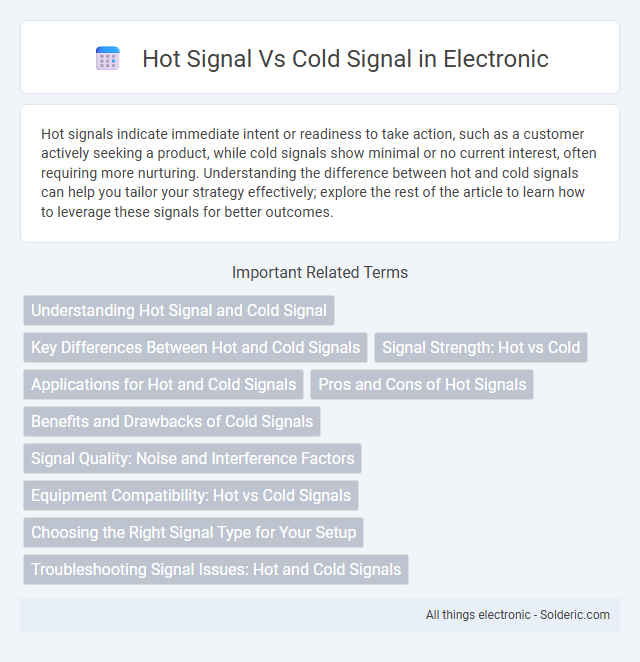Hot signals indicate immediate intent or readiness to take action, such as a customer actively seeking a product, while cold signals show minimal or no current interest, often requiring more nurturing. Understanding the difference between hot and cold signals can help you tailor your strategy effectively; explore the rest of the article to learn how to leverage these signals for better outcomes.
Comparison Table
| Aspect | Hot Signal | Cold Signal |
|---|---|---|
| Definition | Strong, positive indication of intent or interest | Weak or ambiguous indication with uncertain intent |
| Example | Direct inquiry, active engagement | Passive observation, vague mention |
| Response Time | Requires immediate follow-up | Can be nurtured over time |
| Conversion Likelihood | High probability | Low probability |
| Sales Priority | Top priority | Lower priority |
| Engagement Level | Active and intentional | Passive and uncertain |
Understanding Hot Signal and Cold Signal
Hot signals indicate strong buyer intent or immediate interest, often demonstrated through direct inquiries, purchases, or clear engagement with a product or service. Cold signals reflect low or uncertain interest, such as passive browsing or minimal interaction, requiring more nurturing to convert into leads. Understanding these signals helps you tailor your marketing strategies to prioritize high-potential prospects and efficiently allocate resources.
Key Differences Between Hot and Cold Signals
Hot signals indicate active interest or immediate buying intent in a product or service, often reflected by direct inquiries or specific product searches. Cold signals, on the other hand, represent passive or initial awareness, such as general browsing or casual social media engagement without clear intent to purchase. Understanding these distinctions helps you tailor marketing strategies to effectively nurture leads through targeted communication based on their engagement level.
Signal Strength: Hot vs Cold
Signal strength in hot signals is typically much higher than in cold signals, as hot signals indicate recent, active interest or engagement, often leading to quicker conversions. Cold signals show weaker strength due to their older or passive nature, requiring more time and nurturing to build trust and interest. In marketing, leveraging hot signals enhances targeting precision by focusing on warm leads with stronger buying intent.
Applications for Hot and Cold Signals
Hot signals are utilized in targeted marketing campaigns where immediate customer intent is apparent, such as abandoned cart reminders and real-time personalized offers, driving higher conversion rates. Cold signals apply in lead nurturing and brand awareness strategies by engaging potential customers with minimal prior interaction through educational content and broad targeting. Businesses optimize sales funnels by combining hot signals for rapid conversions and cold signals for long-term relationship building.
Pros and Cons of Hot Signals
Hot signals provide real-time, high-quality leads by indicating a prospect's immediate interest or intent, which can significantly increase conversion rates and reduce sales cycles. However, these signals can be resource-intensive to monitor and may lead to missed opportunities if the sales team is not promptly responsive. Your strategy benefits from leveraging hot signals carefully, balancing immediacy with efficient follow-up to maximize potential.
Benefits and Drawbacks of Cold Signals
Cold signals offer the benefit of reaching a larger audience quickly, helping you expand your network beyond immediate contacts. However, the drawbacks include lower response rates and a higher chance of being ignored or marked as spam since recipients have no prior relationship with you. Careful personalization and targeting can mitigate some drawbacks, improving your cold outreach effectiveness.
Signal Quality: Noise and Interference Factors
Hot signals typically exhibit higher quality due to stronger signal strength and reduced susceptibility to noise and interference, resulting in clearer data transmission. Cold signals, in contrast, often experience lower signal-to-noise ratios, making them more vulnerable to distortion and degradation from background interference. Effective signal processing techniques are essential to mitigate these challenges and enhance the overall communication reliability.
Equipment Compatibility: Hot vs Cold Signals
Hot signals carry their own voltage and power, making them compatible with active or powered equipment such as amplifiers and powered speakers, ensuring a strong and clear connection without noise interference. Cold signals lack inherent power and rely on external devices to provide signal strength, typically used with passive equipment like electric guitars or unpowered mixers. Matching signal type to equipment compatibility prevents signal degradation and preserves audio fidelity in professional sound setups.
Choosing the Right Signal Type for Your Setup
Selecting the right signal type for your setup depends on whether you prioritize audio quality or compatibility. Hot signals provide a stronger, line-level output ideal for running through mixers or audio interfaces with minimal noise, ensuring your sound remains clear and powerful. Your choice between hot and cold signals influences the overall integrity and performance of your audio system.
Troubleshooting Signal Issues: Hot and Cold Signals
Troubleshooting signal issues requires understanding the difference between hot and cold signals, where hot signals carry powered audio outputs and cold signals are unpowered, such as microphone-level signals. Hot signals often face interference or distortion due to improper grounding or faulty cables, while cold signals are more susceptible to noise and signal loss without proper preamplification. Correctly identifying the signal type helps in selecting appropriate connectors, balanced or unbalanced cables, and ensuring optimal signal integrity during audio setups.
hot signal vs cold signal Infographic

 solderic.com
solderic.com